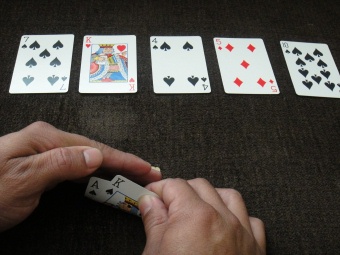|
|

Flush – A completed poker hand consisting of five non-sequential cards of the same suit.
A flush is a moderately strong poker hand which consists of five cards of the same suit. It is ranked higher than a
straight but lower than a
full house. A flush may contain some sequential
cards, but if all five cards are in sequence, you hold a
“straight flush,” which is a much stronger
hand than a regular flush. In fact, a straight flush is the highest ranked poker hand you can make, so long as wild cards are not in play.
The highest ranked straight flush is a suited A-Q-K-J-T, which is also known as a
“Royal Flush,” or more simply, a “Royal.”
A standard poker deck contains fifty two cards, thirteen of each suit. In order to make a flush, you must collect five of them. On its
face, this may seem very easy, considering how strongly a flush ranks at the conclusion of the hand. The problem is that as you
collect more suited cards, fewer of them remain in the deck. This makes it more difficult to complete the flush than you might
imagine. Consider a situation where you have four to a flush on your first four cards. Before the hand started, your suit was 13 out
of 52 cards or 25% of the deck. Now, consider the state of the deck after you have four-flushed (held four to a flush). Since you hold
four suited cards, they no longer remain in the deck. That leaves 9 out of 13 suited cards left and 48 out of 52 cards over all. So
the odds of you catching your flush on fifth street have decrease from 13/52 (25%) to 9/48 (18.75%). Your completion percentage can
fall much lower if your opponents also hold cards of your suit.
Flush draws are often an all or nothing proposition. A flush is a strong hand and will win a high percentage of the time when
completed. However, when you miss a flush, you are often left with a very weak hand, which may not be able to beat even a single pair.
This is because pairs and three of a kind necessarily contain different suits, but someone on a flush draw is collecting cards of the
same suit. This is one reason it is important that you are able to distinguish when your opponents are on flush draws. If you can put
them on a flush draw, you can use this information to your advantage.
Since you already suspect that your opponent is on a flush draw, you know which cards are likely to complete their hand. If they
catch, you are not under any obligation to pay them if you hold a hand that cannot beat a flush. When they do catch, it is often
correct to muck your hand, saving a bet, instead of paying off your opponent. Remember, a bet saved is a bet earned. If you suspect
your opponent has not completed his flush, you will have an opportunity to bluff raise or to take the pot simply by betting. It
doesn’t matter what you hold, and it really doesn’t even matter if you have the best hand or not. You could even be on a busted draw
yourself. In this situation, you should play at the pot simply because you do not think that your opponent will be able to call.
A flush is often an all or nothing proposition, but it doesn’t have to be. A flush draw can be held in concert with a straight draw,
pairs, or three of a kind. This is called a multi-way draw, and it makes your hand much stronger than if you held only a dry flush
draw. A multi way draw gives you more ways to complete your hand, in other words, more
outs. As you know, the
value of your holding is determined, in large part,
by how many outs you have.
When deciding on whether or not to take a flush draw, you must be conscious of what your opponents hold, and are likely drawing to. It
is difficult enough to complete a five card flush. You do not want to draw to it if you are still likely to lose the hand even when
you complete. If your opponent already holds a full house or better, you are drawing dead with your flush draw. If they are also
drawing to a flush, it is possible for you to complete your hand and lose to a higher flush, especially if their draw contains cards
of a higher rank than your draw. You should also take
note if your opponents hold any blockers. If they are holding several of the cards that you need to complete your flush, they have
significantly impeded your ability to complete your hand and win the pot.
Usage: Busted Flush Draw, Four-Flushed, Ace High Flush, Small Flush
Previous Poker Term: Flop Games
Next Poker Term: Flush Draw |
|









